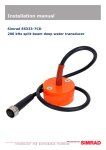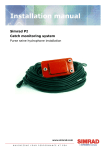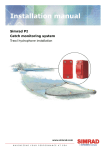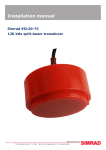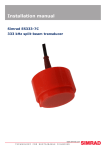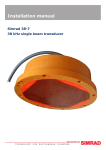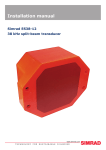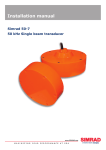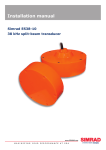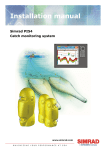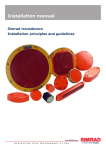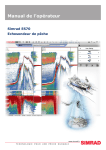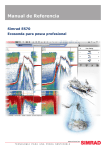Download Simrad ES120-7CD - REV A Installation manual
Transcript
Installation manual Simrad ES120-7CD 120 kHz split-beam deep water transducer www.simrad.com TECHNOLOGY FOR SUSTAINABLE FISHERIES Simrad ES120-7CD Installation manual This document provides a general description of how to install the Simrad ES120-7CD Split-beam transducer. The information must be regarded as general guidelines and recommendations only. The installation shipyard must design and manufacture installation hardware to fit the ES120-7CD transducer on each individual towed body. 339149/A 2 October 2009 Document history Simrad document number: 339149 / ISBN: 978-82-8066-110-4 / Current revision: A Rev.A 02.10.2009 First version. Copyright ©2009 Kongsberg Maritime AS The information contained in this document remains the sole property of Kongsberg Maritime AS. No part of this document may be copied or reproduced in any form or by any means, and the information contained within it is not to be communicated to a third party, without the prior written consent of Kongsberg Maritime AS. The document, or any part of it, may not be translated to any other language without the written approval from Kongsberg Maritime AS. Disclaimer Kongsberg Maritime AS endeavours to ensure that all information in this document is correct and fairly stated, but does not accept liability for any errors or omissions. Warning The equipment to which this manual applies must only be used for the purpose for which it was designed. Improper use or maintenance may cause damage to the equipment and/or injury to personnel. The user must be familiar with the contents of the appropriate manuals before attempting to install, operate or work on the equipment. Kongsberg Maritime AS disclaims any responsibility for damage or injury caused by improper installation, use or maintenance of the equipment. Support If you require maintenance or repair, contact your local dealer. You can also contact us using the following address: -. If you need information about our other products, visit our web site. On the web site you will also find a list of our dealers and distributors. S im r a d Ko n g s b e r g M a r it im e A S S t ra n d p rom e n a d e n 5 0 P. O. Bo x 1 1 1 N- 3 1 9 1 H o r t e n , N o r w a y Te le p h o n e : + 4 7 3 3 0 3 4 0 0 0 Te le fa x : + 4 7 3 3 0 4 2 9 8 7 w w w . s im r a d . c o m c o n t a c t @ s im r a d . c o m Installation manual Table of contents ABOUT THIS MANUAL ....................................................... 5 SIMRAD ES120-7CD .......................................................... 6 TOWED BODY DESIGN ...................................................... 7 HOW TO INSTALL THE TRANSDUCER ................................ 9 Examples ..................................................................................................................9 Example 1: Small transducer ....................................................................... 10 Example 2: Medium and large transducers ................................................... 11 Example 3: Dual transducer arrangement ..................................................... 12 TRANSDUCER HANDLING AND MAINTENANCE ................ 13 Rules for transducer handling.................................................................................13 Approved anti-fouling paints..................................................................................14 Using self-locking taps ...........................................................................................14 Introduction to Emuge self-locking threads................................................... 15 Drawing standard........................................................................................ 16 Taps and gauges.......................................................................................... 16 Self-lock taps provided by Simrad ............................................................... 17 Supplier and manufacturer........................................................................... 17 DRAWING FILE ............................................................... 18 Echo sounder connections ......................................................................................18 Splicing the transducer cable ....................................................................... 18 General Purpose Transceiver (GPT) wiring................................................... 19 General Purpose Transceiver (GPT) transducer plug assembly ....................... 20 Outline dimensions and installation drawings........................................................21 Outline dimensions [324407]....................................................................... 22 Mounting ring [204675] .............................................................................. 23 Clamping ring [204677] .............................................................................. 25 339149/A 3 Simrad ES120-7CD 4 339149/A About this manual ABOUT THIS MANUAL Purpose The purpose of this installation manual is to provide generic descriptions and illustrations allowing the reader to understand the basic principles for echo sounder transducer installation. About the information provided in this document The information in this document must be regarded as general guidelines and recommendations only. The installation shipyard must design and manufacture installation hardware to fit each individual transducer and vessel. Approval by maritime authorities Whenever required, the installation shipyard must also have the installation approved by the applicable maritime authorities. Additional information For additional detailed information about the transducer to be installed, refer to the documentation provided with the transducer. Drawings and descriptions can also be obtained from http://www.simrad.com. 339149/A 5 Simrad ES120-7CD SIMRAD ES120-7CD The purpose of this manual is the provide the basic information required to install the Simrad ES120-7CD Split-beam transducer. Transducer and documents • Simrad ES120–7CD: 324410 • Product specification: 339095 • Drawings: – Outline dimensions: 324407 – Mounting ring: 871–204675 – Clamping ring: 871–204677 Note Although drawings are provided to explain the installation principles, the installation shipyard must provide the final drawings required to fit the transducer to each individual vessel. Also, when applicable, the installation shipyard must have the drawings and installation approved by the proper maritime authorities. The drawings specific for the ES120-7CD transducer are located in the Drawing file on page 18. Technical specifications Refer to the ES120-7CD product specification. Additional parts provided for installation The following items can be supplied by Simrad to facilitate installation: • Mounting ring: ES1–204719 • Clamping ring: ES1–203672 • Transducer cable (for extension): 642–078215 Note This cable is NOT suitable as a tow cable! • The following parts must (if required) be provided by the installation shipyard: – Male bulkhead connector: 8–pin Burton 5500 Series (www.burtonee.com) 6 339149/A Towed body design TOWED BODY DESIGN A towed body used to hold the transducer is not provided by Simrad. The design and manufacturing of such a body must be made by your own organisation, or by a third party you wish to engage to do this. During the design phase, the following considerations must be made. Figure 1 Example, towed body (CD017201C) D E C B A A Transducer mounted through the body plating by means of a mounting ring B Watertight compartment with transceiver electronics C Tail fin D Tow line with built-in cables for power supply, control and data transfer (ethernet) E Fairings Location of transceiver electronics If your towed body design comprises a watertight compartment, you may choose to install the transceiver circuitry inside the towed body. In order to do so, you must install watertight sockets on the bulkhead in order to connect the transducer cable(s), control and data transfer (Ethernet) and operating power. By using a this arrangement, you avoid the signal loss you may experience using a long transducer cable. Depth The upper water layers of the sea contain a myriad of small air bubbles created by the breaking waves. In heavy seas the uppermost 5 to 10 metres may be air-filled, with the highest concentrations near the surface. Air bubbles absorb and reflect 339149/A 7 Simrad ES120-7CD the sound energy, and may in worst cases block the sound transmission totally. Therefore, design the towed body so that it can operate in deep water. Caution Observe the maximum operational depth of the transducer. Do not exceed this limitation. Do not allow the towed body to hit the sea bed. This may inflict permanent damage to the transducer(s). Noise from protruding objects on the body Objects protruding from the towed body, such as zinc anodes, sonar transducers or even a rudder or a keel, may generate turbulence and flow noise. Holes and pipe outlets are also possible noise sources, as these may act as resonant cavities amplifying the flow noise at certain frequencies. Do not place an echo sounder transducer in the vicinity of such objects, and especially not close behind them. For the same reason, it is very important that the body area adjacent to the transducer face is as smooth and level as possible. Even traces of sealing compound, sharp edges, protruding bolts or bolt holes without filling compound will create noise. Inclination of the transducer face Ideally, the transducer face should be mounted in parallel with the sea surface when the towed body is in normal trim, as this will provide the most accurate echo information. However, it is also very important that the water flow over the transducer face is laminar. In order to ensure laminar flow, the transducer face may be tilted slightly upwards in relation to the water flow. This allows the flowing water to meet the face directly, and assures laminar flow. The inclination angle must however be determined carefully. The angle must be small on transducers with narrow beam angles. As a rule of thumb, mount transducers with beam angles smaller than seven degrees with minimum inclination angle. The smaller beam angle your transducer has, the smaller the inclination angle can be. Make sure that you do not mount the transducer with a negative inclination angle. This may cause turbulence under the transducer face, and reduced echo sounder performance. 8 339149/A How to install the transducer HOW TO INSTALL THE TRANSDUCER Installation on a towed body Transducers designed to withstand large water pressure are provided for use in towed bodies. The recommended installation method is through the hull plating hull using mounting and clamping rings. The installation arrangement on the towed body must be designed by the manufacturer of the towed body to fit its shape and characteristics. Use mounting and clamping rings whenever provided Circular transducers may be provided with mounting and clamping rings, or with drawings to allow for local production of these. The mounting ring is welded to the hole in the towed array, while the clamping ring fits around the edge of the transducer body. Bolts through the clamping ring into the mounting ring will then secure the transducer between them. Note that all split-beam transducers use direction guides to allow correct mounting. Smooth surface is important Mounting screws or bolts must not be extruding from the vehicle. Ensure that the surface of the transducer face, the vehicle, the vehicle plating and putty around the transducer is as even and smooth as possible. Obstructions on these surfaces will create problems with the water flow. Examples Observe the following examples of transducer installation. 339149/A 9 Simrad ES120-7CD Example 1: Small transducer The illustration below shows the installation principle of a small circular transducer using clamping and mounting rings. Figure 2 Installation principle, small transducer A B C A Mounting ring B Hull plating on towed body C Transducer D Clamping ring E Bolt 10 D E (CD017010H) 339149/A How to install the transducer Example 2: Medium and large transducers The illustration below shows the installation principle of a medium or large transducers. Note that a clamping ring is not required, as the transducer body is shaped to facilitate this function. Figure 3 Installation principle, medium and large transducers A A Mounting ring B Hull plating on towed body C Transducer D “Clamping ring” functionality facilitated by transducer body E Bolt 339149/A B C D (CD017010G) E 11 Simrad ES120-7CD Example 3: Dual transducer arrangement The illustration below shows a typical through the hull installation of small and large circular transducers on a towed body. Figure 4 Dual transducer arrangement (CD017201B) C A 12 B A Small transducer B Medium or larger transducer C Electronic equipment in watertight compartment 339149/A Transducer handling and maintenance TRANSDUCER HANDLING AND MAINTENANCE You MUST observe the following rules for handling, maintenance and painting. Rules for transducer handling Note Do not lift the transducer by the cable. Do not expose the transducer to direct sunlight. Do not expose the transducer to excessive heat. Transport protection Some transducers are delivered with a cover plate on the face for protection during transport. Let this plate stay on as long as possible, but do not forget to remove it before the vessel goes into the sea. Painting the transducer face An anti-fouling paint may be applied to the transducer face. Because some paint types may be aggressive to the polyurethane in the transducer face, please consult Simrad’s list of approved paints. See Approved anti-fouling paints on page 14. Cleaning the transducer face Whenever opportunity arise, for example when the vessel is dry docked, the transducer face may be cleaned for shells and other marine fouling. Be careful not to make cuts in the transducer face. Use a piece of soft wood or a very fine grade emery paper. Special rules for acoustic windows Arctic tanks have acoustic windows made of polycarbonate. These must neither be painted nor cleaned with chemicals. Acoustic windows must not be exposed to direct sunlight. 339149/A 13 Simrad ES120-7CD Approved anti-fouling paints This is Simrad’s list of approved antifouling paints on polyurethane transducer housing. Jotun Head office address: P.O.Box 2021, N-3248 Sandefjord, Norway Website: www.jotun.com. 1 Racing 2 Non-stop 3 Safeguard Universal primer (125 micron) with Antifouling SeaQuantum Ultra (125 micron) 4 Antifouling Seaguardian International Marine Coatings Address: World-wide offices Website: www.international-marine.com. 1 Intersleek tie coat + 425 FCS • BXA386/BXA390/BXA391 Grey • HKA563/HKA570/HKA571 Yellow • Mix BXA386, BXA390 and BXA391 first, then apply. When dry, mix HKA563, HKA570 and HKA571, apply. 2 Intersmooth 360 Ecoloflex SPC 3 Micron Extra Hempel IFA Coatings Head office address: Hempel A/S, Lundtoftevej 150, Kgs. Lyngby, DK-2800 Copenhagen, Denmark Website: www.hempel.com. 1 Hempel A/F Classic 76550 Note Refer to the manufacturer’s documentation and data sheets for a complete procedure. Using self-locking taps Screw connections are generally made so that they can be loosened again. However, accidental loosening, especially under dynamic stress, must be avoided. For this reason it is often necessary to use additional locking devices. These are often expensive, they can be used once only, or react critically to temperature changes. 14 339149/A Transducer handling and maintenance Introduction to Emuge self-locking threads Emuge self-lock is a tap design with an integrated locking feature. Standard metric bolts are used. The internal thread provides a self-locking connection, which can be used repeatedly. It is not necessary to involve a secondary locking device (e.g. chemical, nylon or mechanical). The Emuge self-lock bolts withstand vibrations better than standard (metric) threads, because the thread contact stops the sideways movement. The special design of the internal thread profile also provides a more even distribution of the tightening stress over the whole thread length. The assembly is just as easy as with a normal (metric) thread. There is no general applicable standard (e.g. DIN standard) for the Emuge self-lock thread. Figure 5 Example, internal and external threads A B C 2 1 (CD017020B) A Emuge’s saw-tooth profile up to pitch P ≤ 0.7 mm B Emuge’s saw-tooth profile up to pitch P ≥ 0.7 mm C Standard thread 1 External thread 2 Internal thread Advantages • The thread locking feature is integrated in the internal thread • Modified profile with ramp surface in the direction of stress • 30 degree ramp surface provides self-locking effect • Easy assembly • No assembly errors (forgetting the locking device) possible • Use of standard external threads (screws) with tolerance class “medium” • Even distribution of stress over the whole thread length • No stripping of threads 339149/A 15 Simrad ES120-7CD • Economically efficient locking system, no additional components are necessary • Undiminished holding power even under dynamic stress • Repeated loosening and re-tightening without loss of function • Internal threads can be produced with Emuge taps, cold forming taps or thread mills • Larger thread hole diameters, i.e. increased tool life for threading tools • Larger tolerances for thread hole diameters Drawing standard Whenever self-locking threads are required, this is shown on the technical drawing. In the case of tapping through holes, the arrow at the end of the center line illustrates the screw-in direction of the bolt. Figure 6 Drawing examples, self-locking thread M8 SL* M10 SL* (CD017020A) The drawing is normally provided with the following text (or similar): Note: The self-lock threads marked with SL* must be made in accordance with procedure 842–202125. Drill diameters for threads differ from standard. Self-lock taps can be supplied by Simrad. Taps and gauges The pretension locking thread self–lock (taps) from manufacturer Emuge must be used. 16 339149/A Transducer handling and maintenance Figure 7 Example of use (CD017020C) Note In the case of tapping through holes it is important that the profile of the Emuge self-lock threads is in the correct direction compared with the entering direction of the bolt. Use Emuge self-lock gauges. Note that the gauge must be used in the correct direction. Self-lock taps provided by Simrad The following self-lock taps are on stock at Simrad, and can be ordered from us. Threads Drill diameter for threads Part.no M6 ø5.2 700-078838 M8 ø7.0 700-078531 M10 ø8.8 700-078408 M12 ø10.7 700-078409 M16 ø14.5 700-078410 Supplier and manufacturer Norwegian supplier is: Tingstad AS, P.O.Box 83, Kalbakken, 0902 Oslo, Norway http://www.tingstad.no Manufacturer is: EMUGE-Werk Richard Glimpel, Nurnberger Strasse 96-100, D-90607 Lauf, Germany http://www.emuge.de 339149/A 17 Simrad ES120-7CD DRAWING FILE This chapter contains relevant drawings related to the electrical and physical installation of the Simrad ES120-7CD Split-beam transducer. Note The mechanical drawings are for information and guidance only. They are not in scale, and may differ slightly from the original drawings. All dimensions are in mm unless otherwise is noted. The original installation drawings are available on PDF and/or AutoCad format. Visit www.simrad.com to download. Topics • Echo sounder connections on page 18 • Outline dimensions and installation drawings on page 21 Echo sounder connections Observe the following information related to electrical connection of the ES120-7CD Split-beam transducer. Splicing the transducer cable If you need to splice the transducer cable, it is very important to use the correct cable, and to avoid ground loops. We strongly recommend the use of a junction box. 18 339149/A Drawing file General Purpose Transceiver (GPT) wiring Observe the drawing below to connect the Simrad ES120-7CD Split-beam transducer to the General Purpose Transceiver (GPT). For more information about these connections, refer to the applicable echo sounder installation manual. 3 2 1 6 5 4 8 Pin 1 Pin 4 Pin 2 Pin 5 Pin 3 Pin 6 Pin 7 Pin 8 + + + + - Burton connector GPT Transducer socket B 7 Q1 Aft starboard Q2 Aft port Q3 Fore port Q4 Fore starboard Forward 3 4 2 1 Port A N M C L D K E F H J Starboard Quadrants seen from top of the transducer Connection box with Burton socket 1 4 1 4 Quadrant 1 H J 2 5 2 5 Quadrant 2 E F 3 6 3 6 Quadrant 3 C D 7 8 7 8 Quadrant 4 A B Screen to plug housing W802-1 1 Rev.A 339149/A Deep water transducer , termination 19 Simrad ES120-7CD General Purpose Transceiver (GPT) transducer plug assembly Upper plug case Plug fastening ring Contact body Retaining ring Outer screen and inner screen braid wire untaped and spread out under washer Outer screen together with inner screen. Drain wire, fold back over jacket and temporary fastened with tape. Heat-shrinkable tubing Lower plug case Washers Bottom cap and cable clamp Rubber sleeve Rubber sleeve Note: All measurements are in mm. The drawing is not in scale. 20 CD010219A Page 1 of 1 824-201575 Rev .C 339149/A Drawing file Outline dimensions and installation drawings Note Observe the 32 Nm torque when the transducer is mounted using the mounting and clamping rings. Observe the 17 Nm maximum torque when the transducer is mounted using the threaded inserts on the transducer body . Topics • Outline dimensions [324407] on page 22 • Mounting ring [204675] on page 23 • Clamping ring [204677] on page 25 339149/A 21 Simrad ES120-7CD Outline dimensions [324407] Maximum tightening torque (M8): 17 Nm Nonstated radii: 2 mm Cable length: 1,5 m Weight in air: 4,5 kg Weight in water: 2,2 kg (76) M8, depth 12 mm ø130 ø152 (Bottom) R1 Guide cam FOR WARD R5 ø180 80 ø24 70,2 85,2 R1 All measurements are in mm The drawing is not in scale 22 324407 Rev .B CD017028-001 Page 1 of 1 339149/A Drawing file Mounting ring [204675] 339149/A 23 Simrad ES120-7CD 24 339149/A Drawing file Clamping ring [204677] 339149/A 25 Simrad ES120-7CD 26 339149/A Index Index A About, 5 information in this manual, 5 Additional information, 5 Air bubbles, 7 Anti-fouling paint, 14 Approval maritime authorities, 5 C Clamping ring blister, 9 drawing, 25 example, 10 D Depth, 7 Dimensions drawing, 22 Drawing Clamping ring, 25 GPT Transducer plug, 20 Mounting ring, 23 outline dimensions, 22 Drawing file, 18 E Emuge, 15 Example Clamping ring, 10 Mounting ring, 10 G GPT Transducer plug drawing, 20 H Handling, 13 Handling rules, 13 Heat, excessive do NOT expose, 13 I Inclination angle, 8 Installation 339149/A drawings, 6, 18 hardware, 6 responsibility, 6 Installation method Towed body, 9 Introduction, 6 L Laminar flow, 8 Lifting, 13 T Taps, self-locking, 15 Towed body installation, 9 Transceiver circuitry location, 7 Transducer depth, 7 lifting, 13 order number, 6 Transducer plug drawing, 20 M Maintenance, 13 Maritime authorities approval, 5 Mounting ring blister, 9 drawing, 23 example, 10 W Watertight, 7 N Noise air bubbles, 7 protruding objects, 8 O Order number transducer, 6 Outline dimensions drawing, 22 P Paint anti-fouling, 14 Physical dimensions drawing, 22 Protruding objects, 8 Purpose this manual, 5 S Self-locking taps, 15 Simrad website, 5 Smooth surface, 9 Sunlight do NOT expose, 13 Surface blister, 9 27 Simrad document number: 339149 ISBN-13: 978-82-8066-110-4 ©2009 Kongsberg Maritime AS S im r a d Ko n g s b e r g M a r it im e A S S t ra n d p rom e n a d e n 5 0 P. O. Bo x 1 1 1 N- 3 1 9 1 H o r t e n , N o r w a y Te le p h o n e : + 4 7 3 3 0 3 4 0 0 0 Te le fa x : + 4 7 3 3 0 4 2 9 8 7 w w w . s im r a d . c o m c o n t a c t @ s im r a d . c o m
































